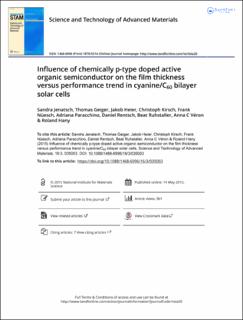Bitte benutzen Sie diese Kennung, um auf die Ressource zu verweisen:
https://doi.org/10.21256/zhaw-1988| Publikationstyp: | Beitrag in wissenschaftlicher Zeitschrift |
| Art der Begutachtung: | Peer review (Publikation) |
| Titel: | Influence of chemically p-type doped active organic semiconductor on the film thickness versus performance trend in cyanine/C60 bilayer solar cells |
| Autor/-in: | Jenatsch, Sandra Geiger, Thomas Heier, Jakob Kirsch, Christoph Nüesch, Frank Paracchino, Adriana Rentsch, Daniel Ruhstaller, Beat Véron, Anna C. Hany, Roland |
| DOI: | 10.21256/zhaw-1988 10.1088/1468-6996/16/3/035003 |
| Erschienen in: | Science and Technology of Advanced Materials |
| Band(Heft): | 16 |
| Heft: | 3 |
| Erscheinungsdatum: | 14-Mai-2015 |
| Verlag / Hrsg. Institution: | Taylor & Francis |
| ISSN: | 1468-6996 1878-5514 |
| Sprache: | Englisch |
| Schlagwörter: | Organic solar cell; Bilayer; Cyanine dye; Doping |
| Fachgebiet (DDC): | 621.3: Elektro-, Kommunikations-, Steuerungs- und Regelungstechnik |
| Zusammenfassung: | Simple bilayer organic solar cells rely on very thin coated films that allow for effective light absorption and charge carrier transport away from the heterojunction at the same time. However, thin films are difficult to coat on rough substrates or over large areas, resulting in adverse shorting and low device fabrication yield. Chemical p-type doping of organic semiconductors can reduce Ohmic losses in thicker transport layers through increased conductivity. By using a Co(III) complex as chemical dopant, we studied doped cyanine dye/C60 bilayer solar cell performance for increasing dye film thickness. For films thicker than 50 nm, doping increased the power conversion efficiency by more than 30%. At the same time, the yield of working cells increased to 80%. We addressed the fate of the doped cyanine dye, and found no influence of doping on solar cell long term stability. |
| URI: | https://digitalcollection.zhaw.ch/handle/11475/6922 |
| Volltext Version: | Publizierte Version |
| Lizenz (gemäss Verlagsvertrag): | CC BY 3.0: Namensnennung 3.0 Unported |
| Departement: | School of Engineering |
| Organisationseinheit: | Institute of Computational Physics (ICP) |
| Enthalten in den Sammlungen: | Publikationen School of Engineering |
Dateien zu dieser Ressource:
| Datei | Beschreibung | Größe | Format | |
|---|---|---|---|---|
| 2015_ruhb_Influence_of_chemically_p_type.pdf | 2.02 MB | Adobe PDF |  Öffnen/Anzeigen |
Zur Langanzeige
Jenatsch, S., Geiger, T., Heier, J., Kirsch, C., Nüesch, F., Paracchino, A., Rentsch, D., Ruhstaller, B., Véron, A. C., & Hany, R. (2015). Influence of chemically p-type doped active organic semiconductor on the film thickness versus performance trend in cyanine/C60 bilayer solar cells. Science and Technology of Advanced Materials, 16(3). https://doi.org/10.21256/zhaw-1988
Jenatsch, S. et al. (2015) ‘Influence of chemically p-type doped active organic semiconductor on the film thickness versus performance trend in cyanine/C60 bilayer solar cells’, Science and Technology of Advanced Materials, 16(3). Available at: https://doi.org/10.21256/zhaw-1988.
S. Jenatsch et al., “Influence of chemically p-type doped active organic semiconductor on the film thickness versus performance trend in cyanine/C60 bilayer solar cells,” Science and Technology of Advanced Materials, vol. 16, no. 3, May 2015, doi: 10.21256/zhaw-1988.
JENATSCH, Sandra, Thomas GEIGER, Jakob HEIER, Christoph KIRSCH, Frank NÜESCH, Adriana PARACCHINO, Daniel RENTSCH, Beat RUHSTALLER, Anna C. VÉRON und Roland HANY, 2015. Influence of chemically p-type doped active organic semiconductor on the film thickness versus performance trend in cyanine/C60 bilayer solar cells. Science and Technology of Advanced Materials. 14 Mai 2015. Bd. 16, Nr. 3. DOI 10.21256/zhaw-1988
Jenatsch, Sandra, Thomas Geiger, Jakob Heier, Christoph Kirsch, Frank Nüesch, Adriana Paracchino, Daniel Rentsch, Beat Ruhstaller, Anna C. Véron, and Roland Hany. 2015. “Influence of Chemically P-Type Doped Active Organic Semiconductor on the Film Thickness versus Performance Trend in Cyanine/C60 Bilayer Solar Cells.” Science and Technology of Advanced Materials 16 (3). https://doi.org/10.21256/zhaw-1988.
Jenatsch, Sandra, et al. “Influence of Chemically P-Type Doped Active Organic Semiconductor on the Film Thickness versus Performance Trend in Cyanine/C60 Bilayer Solar Cells.” Science and Technology of Advanced Materials, vol. 16, no. 3, May 2015, https://doi.org/10.21256/zhaw-1988.
Alle Ressourcen in diesem Repository sind urheberrechtlich geschützt, soweit nicht anderweitig angezeigt.